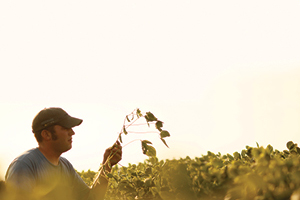ROOT TRAVEL
“When you look at plant roots and consider that, for example, a nutrient like phosphorus is very critical for early seedling nutrition, you should also consider the direction the corn roots go – they tend to go out and downward at a 45-degree angle.
“So the traditional 2×2 band, a band 2 inches below and beside the seed row, is very suitable for phosphorus nutrition for corn. When you look at soybean roots, they tend to go more straight down at the beginning, so nutrients possibly need to be just below the seed. It’s much harder, though, to place nutrients directly below the seed at planting than it is in a band beside the seed.”

SOIL REACTION
“Phosphorus tends to get tied up in the soil. So if you band-apply, one big advantage you have is that you’re exposing your nutrient to less soil, so you have less tie-up.
“When you consider potash, it’s almost the opposite. Potash and chloride – particularly chloride – do not get absorbed by the soil at all. Concentrated in a band, the chloride stays in solution. When that happens, the salt index becomes a problem that poses a risk to the seedlings.”
TILLAGE TYPE
“With tillage, every time you have a tillage operation, you have the opportunity to mix the nutrients in uniformly with the soil, which can be an advantage, particularly in very nutrient-depleted soils.
“In no-till, the nutrients are accumulated near the surface. Some placement tools can inject without disturbing the soil residue cover. In no-till, that’s one of your management goals: Maintain soil residue coverage. So you need to consider ways to get nutrients into the soil without disturbing that soil residue.”
SOIL VARIABILITY
“Recognizing that soils vary within the field is very important. Your soil nutrient level may vary; the expected crop removal varies. And if you’re doing variable-rate application within the field, you need to account for both of those.”
“You may also identify areas that are separate management zones where you require build-up applications. So the application placement that you use there may actually be different from the rest of the field. For instance, you may only need to broadcast-apply to smaller areas of the field. And at the same time, you may give an application to the whole field using a lower rate band-applied.”
RISK OF LOSS
“It’s very important to be paying attention to critical source areas within the field, those areas where runoff is more likely. You also need to be asking yourself if there are sensitive water bodies in the watershed.
“If that’s a concern, then it becomes increasingly important to put a nutrient, like phosphorus, into the soil rather than leaving it on the surface.”
For more information on better placement from Dr. Tom Bruulsema, visit Placing with Purpose